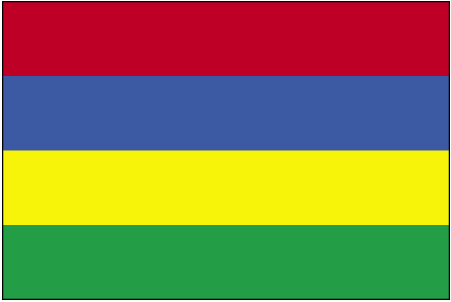

Main ¶ Country Introduction ¶ Country Economy ¶ Country ICT ¶ Country Maps ¶ References ¶
A historical fact about the existence of Mauritius was that it was uninhabited up until the 17th Century. However, Arab and Malay sailors knew about the island centuries earlier (Academic Search Complete). The first European to visit the island was the Portuguese in early 17th century, but they did not established settlement. Years later in 1638, the Dutch colonized the island and brought over Dutch convicts and slaves from Indonesia and Madagascar to exploit some of resources of island such as the ebony, the ambergris, and named the island after the head of state of Holland at the time, Maurice of Nassau. However, because of poor administration of the found resources, the Dutch colony failed and withdrew completely from the island in 1710 (The Library of Congress Online Catalog).
In the same year that the Dutch occupied Mauritius, the French occupied the neighbor island of Rodriguez. So, five years after the Dutch abandoned Mauritius, the French occupied the island, moved in with slaves from Africa, and started sugar plantations. The French colony in Mauritius was ruled for about four decades by the French East Indian company, before the company went bankrupt 1764; therefore, Mauritius became a crown colony directly under the control of the French government.
Under the French government rule, Mauritius flourished. French sugar planters grew wealthier and the population increased particularly that of the African slaves. The capital city Port Luis thrived as it opened up to free trade. It is during this period that United States established its consulate in Port Luis in 1790 (The Library of Congress Online Catalog). Furthermore, it is worth mentioning here that the African slaves that were brought in at this time were the ancestors of today’s Mauritian ethnic group called the Creole ethnic, which is the second largest ethnic group in Mauritius.
It wasn’t until the French revolution in the early century with its weakening consequences of the French hegemony that the British was able to capture the island with a huge army that forced France to capitulate in 1810, and to award both islands Rodriguez and Mauritius to Britain at the treaty of Paris in 1814. At this treaty, the British agreed to leave the administrative structures in place, which was the reason that the sugar plantation and its industries mostly remained under the control of the French, as well as the reason for fewer British settlers in the island.
The British abolished slavery two decades after taking control of Mauritius, precisely in the year 1835. In order to compensate the plantation’s owners for the loss of their free labor or slaves, the British set up an apprenticeship system forcing the freed slaves to remain under their masters’ command for six years as apprentices. Moreover, to compensate for the shortage of labor, due to either desertion of the freed slaves or completion of apprenticeship, the British brought over 450,000 people from the sub-continent of India as indentured workers according to Rosabell Boswell, the author of a book named: Challenges to Identifying and Managing Intangible Cultural Heritage in Mauritius, Zanzibar and Seychelles (Boswell).
The arrival of the Indian indentured workers made labor very cheap and enabled Britain to build and control the country for over a century and half. Besides, these indentured workers are the ancestors of the Indo-Mauritians, which represent the largest ethnic groups in Mauritius as mentioned earlier.
During the WWII, Mauritius served an important naval base for Britain, but after the war ended, social and economic conditions of Mauritians worsened, which led to some political tensions. For example, the social welfare (education, health, etc…) was getting poorer and more than 12 percent of the work force was unemployed. This situation led the country to its independence on March 12th, 1968 and became a member of the Commonwealth of Nations (The Library of Congress Online Catalog).
After the independence, multiple political parties were formed and alternated into executive branch of the government by forming alliances. In March 1992, the coalition government that was ruling the country succeeded to pass changes in the constitution that made Mauritius a Republic. The successive governments that ruled Mauritius after its independence have not only succeeded to rule the country effectively, but they have established a sound and stable democracy unlike many sub-Saharan African nations.
Main ¶ Country Introduction ¶ Country Economy ¶ Country ICT ¶ Country Maps ¶ Reference ¶